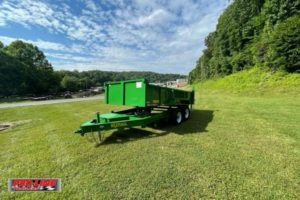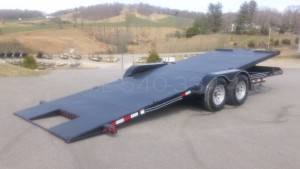Differences Between Single-Acting and Double-Acting Hydraulic Cylinders
There are many different factors to consider when choosing between double or single-acting hydraulic cylinders. Even though double-acting cylinders make up 75% of the cylinder market, there are plenty of situations where a single-acting cylinder is the better option.
Hydraulic cylinders are simple components that do an amazing amount of work. They provide huge amounts of power and make lifting heavy loads as effortless as pushing a button.
One application that depends on hydraulic cylinders daily is tilt and dump trailers. These trailers are the workhorses of various industries such as construction and landscaping.
When you’re trying to decide what type of hydraulic cylinder you should use for your trailer, you need to know how each type works. In this guide, we’ll explain the pros and cons of both types to help you make the right decision.
What Are Hydraulic Cylinders?
These mechanical actuators use a pressurized hydraulic fluid – usually hydraulic oil – to provide a powerful unidirectional force. At a simple level, they consist of a barrel cylinder with a piston that moves back and forth.
The barrel is sealed closed at both ends, and the piston rod extends out of the cylinder head with a sliding seal. By pumping hydraulic fluid into the chamber created by the piston head, the piston rod moves outwards. This movement provides the lifting force in a hydraulic system.
How Does a Single-Acting Cylinder Work?
This type of hydraulic cylinder only provides a lifting force in one direction. They normally have one inlet/outlet port for the hydraulic fluid. As the pressurized fluid flows into the cylinder, the rod extends.
Once it has reached full extension, the weight of the trailer pushes it back down. There is no hydraulic force required to retract the rod. Some single-acting cylinders have a spring inside to assist with pushing the rod back down.
Pros and Cons of Single-Acting Cylinders
One major benefit of single-acting cylinders is that they cost less than double-acting cylinders. They also have fewer components which means they are easier to maintain. With less parts, they are more reliable and less likely to break down.
The only downside is that you’re then dependent on gravity to retract the rod. If you’re looking for a fast – or more controlled – retraction, then a double-acting cylinder is a better choice.
Single-Acting Cylinder Applications
There is a full range of different size single-acting cylinders for all sorts of applications. Larger models are just as capable of lifting high tonnage loads as their double-acting counterparts.
They are mostly used in situations that only require powered lifting. Single-acting cylinders are often used on small dump trailers where the trailer bed’s center of gravity is low enough to close on its own accord.
How Does a Double-Acting Cylinder Work?
The difference here is that the hydraulic fluid pressurizes the rod in both directions – up and down. This is achieved by having two ports for hydraulic fluid at the top and bottom of the cylinder.
To extend the rod, fluid is pumped into the base of the cylinder. When the operator decides to retract the rod, fluid is pumped into the top of the cylinder. This provides a dual-action force that allows for a more controlled extension and retraction of the rod.
Pros and Cons of Double-Acting Cylinders
The biggest advantage of this type of hydraulic cylinder is the ability to control both the extension and retraction of the rod. They are the best cylinder to use in situations where you need careful control of both the extension and retraction.
They are often the preferred cylinder for car tilt trailer applications as the weight of the trailer and the vehicle needs to be gently lowered down onto the trailer frame.
Another benefit is that you can retract the rod much faster than with a single-acting cylinder. On the downside, double-acting cylinders need a bigger pump and more hoses. This makes them more expensive and increases the chances of a component failing.
Double-Acting Cylinder Applications
If you need hydraulic power to lift and lower your trailer bed, then double-acting cylinders are the only option. On many dump trailers, the trailer bed’s center of gravity passes the point of no return when fully extended.
To bring this type of trailer bed back down, you need a double-acting cylinder to power it down onto the trailer’s frame. This is necessary as gravity is pulling the trailer bed the opposite way.
This type of cylinder is the best option for any situation that requires precision lifting and lowering. They are also the only option in applications where the cylinder may be upside down.
What Is a Telescopic Hydraulic Cylinder?
Many dump trailers use telescopic hydraulic cylinders to extend the reach of the trailer bed. These cylinders are most often single-acting and known as multi-stage cylinders.
They consist of four or five tubes or sleeves wrapped around each other. When hydraulic fluid is pumped into them, the largest sleeve extends first. Once it reaches its maximum extension, the next sleeve begins to extend.
This gives them a much larger range of movement than the other types of hydraulic cylinders. Telescopic cylinders are often used on dump trailers as they allow the trailer bed to reach a near vertical position and don’t take up much room within the trailer frame.
Are You Looking Hydraulic Lift Trailer?
Hydraulic cylinders provide the muscle to lift a wide range of tilt and dump trailers – no matter how heavy your load is. Their simple design means they are reliable and easy to repair without specialist knowledge.
If you’re looking for a high-quality dump trailer, then make sure you check out Pro-line Trailers. We have a large selection of new and used trailers for contractors, landscapers, and car enthusiasts. We can custom make any trailer to meet your specific needs and also offer maintenance, repairs, and hydraulic cylinder installations.
You can contact us online or call us at (540) 334-4182 to discuss your trailer requirements.





